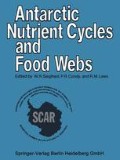Summary
Traditional views on the productivity of the Southern Ocean have changed greatly. High primary production in the shelf region and near the pack-ice and the short diatom-Krill-whale food chain were first taken as indications of a very large renewable resource. However, it is now known that primary production in the open parts of the Southern Ocean is relatively low, and Soviet estimates of Krill, Euphausia superba, stocks have decreased by an order of magnitude. The pelagic Southern Ocean contains 3 major zones which, although they interact, may for convenience be considered as having distinct food webs. These zones are: the ice-free zone of the West Wind Drift dominated by herbivorous copepods, salps and small euphausiids; the seasonal pack-ice zone of the East Wind Drift and adjacent fronts and eddies in which Krill is the dominant element; and the permanent sea-ice zone near the Antarctic continent and its ice shelves where zooplankton biomass is low and, thus, predators are scarce. The Krill system is a product of a long evolutionary process in isolation. It is characterized by high seasonality in light and ice cover but otherwise stable conditions of low temperature and high nutrient supply. Within the Krill-dominated food chain unusually large size steps, and high energy demands for maintenance and swimming, require large concentrations of food to keep the effort for searching and feeding low during the short summer season. This pelagic system running on high energy costs is in contrast to the low energy system of the rich Antarctic benthos, particularly in pack-ice regions. Because survival in the Antarctic is energetically expensive, there is little net gain in the Krill system, despite its short food chain. However, the large biomass stored in Krill swarms and in large vertebrates has made the Krill system attractive to exploitation by man. Antarctic communities typically exhibit K-strategies but paradoxically there is great environmental variability in the pack-ice zone. Any model of food chain dynamics, or any management strategy, must take into account not only the low efficiency of the food chain but also the variability of its key elements.
Access this chapter
Tax calculation will be finalised at checkout
Purchases are for personal use only
Preview
Unable to display preview. Download preview PDF.
References
Bröckel K von (1984) Primary production in the Weddell Sea. Submitted to Polar Biology
Clarke A (1985) Energy flow in the Southern Ocean food web. In: Siegfried WR, Condy PR, Laws RM (eds) Antarctic nutrient cycles and food webs (Proceedings of the 4th SCAR symposium of Antarctic biology). Springer, Berlin Heidelberg New York
Croxall JP, Prince PA, Ricketts C (1985) Relationships between prey life-cycles and the extent nature and timing of seal and seabird predation in the Scotia Sea. In: Siegfried WR, Condy PR, Laws RM (eds) Antarctic nutrient cycles and food webs (Proceedings of the 4th SCAR symposium on Antarctic biology). Springer, Berlin Heidelberg New York
Deacon GER (1982) Physical and biological zonation in the Southern Ocean. Deep-Sea Res 19: 1–15
Gordon AL, Goldberg RD (1970) Circumpolar characteristics of Antarctic waters. Antarctic Map Folio Series 13, Am Geograph Soc New York
Hart TJ (1942) Phytoplankton periodicity in Antarctic surface waters. Discovery Rep 21: 261–356
Hempel G (1983) FIBEX — An international survey in the Southern Ocean: Review and outlook. Mem Nat Inst Polar Res Tokyo. Special Issue 27: 1–15
Hempel I (1983) Studies in eggs and larvae of Euphausia superba and Euphausia crystallorophias in the Atlantic sector of the Southern Ocean. Ber Polarforsch Sonderh 4: 30–46
Hempel I, Hempel G, Baker A de C (1979) Early life history stages of krill (Euphausia superba) in Bransfield Strait and Weddell Sea. Meeresforschung 27: 267–281
Hirche HJ (1983) Overwintering of Calanus finmarchicus and Cala-nus helgolandicus. Mar Ecol Prog Ser 11: 281–290
Hubold G (1985) The early life-history of the high-Antarctic Silverfish, Pleuragramma antarcticum. In: Siegfried WR, Condy PR, Laws RM (eds) Antarctic nutrient cycles and food webs (Proceedings of the 4th SCAR symposium on Antarctic biology). Springer, Berlin Heidelberg New York
Ikeda T, Dixon P (1982) Observations on moulting in Antarctic krill (Euphausia superba Dana). Aust J Mar Freshwater Res 33: 71–76
Kils U (1981) The swimming behaviour, swimming performance and energy balance of Antarctic krill, Euphausia superba. BIOMASS Scientific Series No 3, 122 pp
Kils U (1983) Swimming and feeding of Antarctic krill, Euphausia superba — some outstanding energetics and dynamics, some unique morphological details. Ber Polarforsch Sonderh 4: 130–155
Lubimova et al. (1980) Results of the Soviet research into assessment of stocks, ecology, and the role of krill in the Antarctic ecosystem. Published as manuscript
Luxmoore RA (1985) The energy budget of a population of the Antarctic isopod Serolis polita. In: Siegfried WR, Condy PR, Laws RM (eds) Antarctic nutrient cycles and food webs (Proceedings of the 4th SCAR symposium on Antarctic biology). Springer, Berlin Heidelberg New York
Murphy GI (1972) Fisheries in upwelling regions with special reference to Peruvian waters. Geoforum 11: 63–71
Schnack SB, Smetacek V, von Bodungen B, Stegmann P (1984) Utilization of phytoplankton by copepods in Antarctic waters during spring. In: Gray J (ed) Proc 18th Europ Mar Biol Symp, Oslo. John Wiley, London, New York (to be published)
Voronina NM (1966) The distribution of zooplankton biomass in the Southern Ocean. Deep-Sea Res 29: 1–15
Voronina NM (1971) Annual cycle of Antarctic plankton. In: Beklemishev (ed) Fundamentals of the biological productivity of the ocean and its exploitation. Nauka, Moscow, pp 64–71
Author information
Authors and Affiliations
Editor information
Editors and Affiliations
Rights and permissions
Copyright information
© 1985 Springer-Verlag Berlin Heidelberg
About this paper
Cite this paper
Hempel, G. (1985). Antarctic Marine Food Webs. In: Siegfried, W.R., Condy, P.R., Laws, R.M. (eds) Antarctic Nutrient Cycles and Food Webs. Springer, Berlin, Heidelberg. https://doi.org/10.1007/978-3-642-82275-9_38
Download citation
DOI: https://doi.org/10.1007/978-3-642-82275-9_38
Publisher Name: Springer, Berlin, Heidelberg
Print ISBN: 978-3-642-82277-3
Online ISBN: 978-3-642-82275-9
eBook Packages: Springer Book Archive

